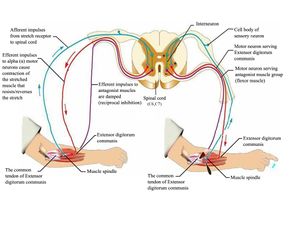Reflexes: Difference between revisions
No edit summary |
(added editor) |
||
| Line 1: | Line 1: | ||
<div class="editorbox"> '''Original Editor '''- [[User:Lucinda hampton|Lucinda hampton]] '''Top Contributors''' - {{Special:Contributors/{{FULLPAGENAME}}}}</div> | |||
<div class="editorbox"> | <div class="editorbox"> | ||
'''Original Editor '''- Your name will be added here if you created the original content for this page. | '''Original Editor '''- Your name will be added here if you created the original content for this page. | ||
Revision as of 04:57, 21 April 2019
Original Editor - Your name will be added here if you created the original content for this page.
Lead Editors
The Reflex Arc[edit | edit source]
 Illustration of the reflex arc.
Illustration of the reflex arc.
A reflex is an involuntary and nearly instantaneous movement in response to a stimulus. The reflex is an automatic response to a stimulus that does not receive or need conscious thought as it occurs through a reflex arc. Reflex arcs act on an impulse before that impulse reaches the brain.[1]
Relex arcs can be
- Monosynaptic ie contain only two neurons, a sensory and a motor neuron. Examples of monosynaptic reflex arcs in humans include the patellar reflex and the Achilles reflex.
- Polysynaptic ie multiple interneurons (also called relay neurons) that interface between the sensory and motor neurons in the reflex pathway.[2]
Technique[edit | edit source]
Describe how to carry out this assessment technique here
Evidence[edit | edit source]
Provide the evidence for this technique here
Resources[edit | edit source]
add any relevant resources here
References[edit | edit source]
- ↑ Wikipedia. Reflex. Available from: https://en.wikipedia.org/wiki/Reflex (last accessed 21.4.2019)
- ↑ Lumen. Reflexes. https://courses.lumenlearning.com/boundless-ap/chapter/reflexes/ (last accessed 21.4.2019)






